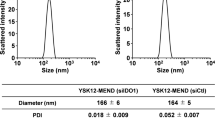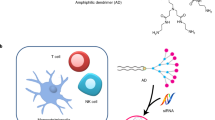Abstract
Cationic liposome represents a promising alternative to viral vectors for the delivery of therapeutic genes. For in vivo use, surface modification of the liposome with polyethylene glycol (PEG) is frequently applied to achieve gene-expression in the targeted tissue. However, we have reported that PEG-coated liposomes have induced anti-PEG IgM, which has caused subsequent doses of PEG-coated liposome to be rapidly cleared from blood circulation, and the complexation of pDNA electrostatically associated with liposome surface has enhanced this antibody response. In this study, we investigated how a Toll-like receptor (TLR) might enhance anti-PEG IgM production. PEG-coated pDNA-lipoplex (PDCL) was injected into either wild type, MyD88 (all TLR adaptor protein, independent of TLR3) knock out (KO) or TLR9 KO mice, and the anti-PEG IgM production levels were detected. Attenuated anti-PEG IgM production following the injection of PDCL was observed in both MyD88 and TLR9 KO mice compared to wild type mice, probably due to the abolished induction of cytokines in both MyD88 and TLR9 KO mice. Our results suggest that TLR, exclusively TLR9, signaling plays a potential role in the enhanced anti-PEG IgM production following the injection of PDCL. This result may have important implications for the design and development of an efficient PEG-coated non-viral gene vector.
This is a preview of subscription content, access via your institution
Access options
Subscribe to this journal
Receive 12 print issues and online access
$259.00 per year
only $21.58 per issue
Buy this article
- Purchase on Springer Link
- Instant access to full article PDF
Prices may be subject to local taxes which are calculated during checkout





Similar content being viewed by others
References
Chen SH, Zhaori G . Potential clinical applications of siRNA technique: benefits and limitations. Eur J Clin Invest 2011; 41: 221–232.
Deshayes S, Morris M, Heitz F, Divita G . Delivery of proteins and nucleic acids using a non-covalent peptide-based strategy. Adv Drug Deliver Rev 2008; 60 (4-5): 537–547.
Lee SY, Huh MS, Lee S, Lee SJ, Chung H, Park JH et al. Stability and cellular uptake of polymerized siRNA (poly-siRNA)/polyethylenimine (PEI) complexes for efficient gene silencing. J Control Release 2010; 141: 339–346.
Sparks J, Slobodkin G, Matar M, Congo R, Ulkoski D, Rea-Ramsey A et al. Versatile cationic lipids for siRNA delivery. J Control Release 2012; 158: 269–276.
Pires P, Simoes S, Nir S, Gaspar R, Duzgunes N, de Lima MCP . Interaction of cationic liposomes and their DNA complexes with monocytic leukemia cells. Bba-Biomembranes 1999; 1418: 71–84.
da Cruz MT, Simoes S, Pires PP, Nir S, de Lima MC . Kinetic analysis of the initial steps involved in lipoplex—cell interactions: effect of various factors that influence transfection activity. Biochim Biophys Acta 2001; 1510 (1-2): 136–151.
Li W, Szoka FC Jr . Lipid-based nanoparticles for nucleic acid delivery. Pharm Res 2007; 24: 438–449.
Drummond DC, Meyer O, Hong KL, Kirpotin DB, Papahadjopoulos D . Optimizing liposomes for delivery of chemotherapeutic agents to solid tumors. Pharmacol Rev 1999; 51: 691–743.
Balazs DA, Godbey W . Liposomes for use in gene delivery. J Drug Deliv 2011; 2011: 326497.
Decastro M, Saijoh Y, Schoenwolf GC . Optimized cationic lipid-based gene delivery reagents for use in developing vertebrate embryos. Dev Dynam 2006; 235: 2210–2219.
Judge A, McClintock K, Phelps JR, MacLachlan I . Hypersensitivity and loss of disease site targeting caused by antibody responses to PEGylated liposomes. Mol Ther 2006; 13: 328–337.
Kaminskas LM, Mcleod VM, Porter CJH, Boyd BJ . Differences in Colloidal Structure of PEGylated Nanomaterials Dictate the Likelihood of Accelerated Blood Clearance. J Pharm Sci-Us 2011; 100: 5069–5077.
Abu Lila AS, Kiwada H, Ishida T . The accelerated blood clearance (ABC) phenomenon: Clinical challenge and approaches to manage. J Control Release 2013; 172: 38–47.
Saadati R, Dadashzadeh S, Abbasian Z, Soleimanjahi H . Accelerated blood clearance of PEGylated PLGA nanoparticles following repeated injections: effects of polymer dose, PEG coating, and encapsulated anticancer drug. Pharm Res 2013; 30: 985–995.
Koide H, Asai T, Kato H, Ando H, Shiraishi K, Yokoyama M et al. Size-dependent induction of accelerated blood clearance phenomenon by repeated injections of polymeric micelles. Int J Pharmaceut 2012; 432 (1-2): 75–79.
Tagami T, Nakamura K, Shimizu T, Yamazaki N, Ishida T, Kiwada H . CpG motifs in pDNA-sequences increase anti-PEG IgM production induced by PEG-coated pDNA-lipoplexes. J Control Release 2010; 142: 160–166.
Hemmi H, Takeuchi O, Kawai T, Kaisho T, Sato S, Sanjo H et al. A Toll-like receptor recognizes bacterial DNA. Nature 2000; 408: 740–745.
West AP, Koblansky AA, Ghosh S . Recognition and signaling by toll-like receptors. Annu Rev Cell Dev Bi 2006; 22: 409–437.
Ishida T, Ichihara M, Wang XY, Kiwada H . Spleen plays an important role in the induction of accelerated blood clearance of PEGylated liposomes. J Control Release 2006; 115: 243–250.
Tagami T, Nakamura K, Shimizu T, Ishida T, Kiwada H . Effect of siRNA in PEG-coated siRNA-lipoplex on anti-PEG IgM production. J Control Release 2009; 137 (3-4): 234–240.
Adachi O, Kawai T, Takeda K, Matsumoto M, Tsutsui H, Sakagami M et al. Targeted disruption of the MyD88 gene results in loss of IL-1- and IL-18-mediated function. Immunity 1998; 9: 143–150.
Kolka JA, Vreede AP, Roessler BJ . Lipopolysaccharide recognition protein, MD-2, facilitates cellular uptake of E-coli-derived plasmid DNA in synovium. J Gene Med 2005; 7: 956–964.
Patil SD, Rhodes DG, Burgess DJ . DNA-based therapeutics and DNA delivery systems: A comprehensive review. Aaps J 2005; 7: E61–E77.
Semple SC, Harasym TO, Clow KA, Ansell SM, Klimuk SK, Hope MJ . Immunogenicity and rapid blood clearance of liposomes containing polyethylene glycol-lipid conjugates and nucleic acid. J Pharmacol Exp Ther 2005; 312: 1020–1026.
Roberts TL, Sweet MJ, Hume DA, Stacey KJ . Cutting edge: Species-specific TLR9-mediated recognition of CpG and non-CpG phosphorothioate-modified ohgonucleotides. J Immunol 2005; 174: 605–608.
Ishida T, Harada M, Wang XY, Ichihara M, Irimura K, Kiwada H . Accelerated blood clearance of PEGylated liposomes following preceding liposome injection: effects of lipid dose and PEG surface-density and chain length of the first-dose liposomes. J Control Release 2005; 105: 305–317.
Cerutti A, Cols M, Puga I . Marginal zone B cells: virtues of innate-like antibody-producing lymphocytes. Nat Rev Immunol 2013; 13: 118–132.
Desmet CJ, Ishii KJ . Nucleic acid sensing at the interface between innate and adaptive immunity in vaccination. Nature Reviews Immunology 2012; 12: 479–491.
Lanzavecchia A, Sallusto F . Toll-like receptors and innate immunity in B-cell activation and antibody responses. Curr Opin Immunol 2007; 19: 268–274.
Rickert RC, Rajewsky K, Roes J . Impairment of T-Cell-Dependent B-Cell Responses and B-1 Cell-Development in Cd19-Deficient Mice. Nature 1995; 376: 352–355.
Maizels N, Lau JC, Blier PR, Bothwell A . The T-cell independent antigen, NP-ficoll, primes for a high affinity IgM anti-NP response. Mol Immunol 1988; 25: 1277–1282.
Swanson CL, Wilson TJ, Strauch P, Colonna M, Pelanda R, Torres RM, Type I . IFN enhances follicular B cell contribution to the T cell-independent antibody response. J Exp Med 2010; 207: 1485–1500.
Jego G, Palucka AK, Blanck JP, Chalouni C, Pascual V, Banchereau J . Plasmacytoid dendritic cells induce plasma cell differentiation through type I interferon and interleukin 6. Immunity 2003; 19: 225–234.
Hatakeyama H, Ito E, Yamamoto M, Akita H, Hayashi Y, Kajimoto K et al. A DNA Microarray-based Analysis of the Host Response to a Nonviral Gene Carrier: A Strategy for Improving the Immune Response. Mol Ther 2011; 19: 1487–1498.
Tagami T, Uehara Y, Moriyoshi N, Ishida T, Kiwada H . Anti-PEG IgM production by siRNA encapsulated in a PEGylated lipid nanocarrier is dependent on the sequence of the siRNA. J Control Release 2011; 151: 149–154.
Bartlett GR . Colorimetric assay methods for free and phosphorylated glyceric acids. J Biol Chem 1959; 234: 469–471.
Acknowledgements
The authors thank Mr JL McDonald for his kind assistance in writing the manuscript. This study was supported, in part, by the Takeda Science Foundation and by a Grant-in-Aid for Scientific Research (B) (23390012) from the Ministry of Education, Culture, Sports, Science and Technology, Japan.
Author information
Authors and Affiliations
Corresponding author
Ethics declarations
Competing interests
The authors declare no conflict of interest.
Rights and permissions
About this article
Cite this article
Hashimoto, Y., Uehara, Y., Abu Lila, A. et al. Activation of TLR9 by incorporated pDNA within PEG-coated lipoplex enhances anti-PEG IgM production. Gene Ther 21, 593–598 (2014). https://doi.org/10.1038/gt.2014.32
Received:
Revised:
Accepted:
Published:
Issue Date:
DOI: https://doi.org/10.1038/gt.2014.32



